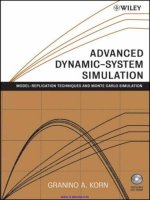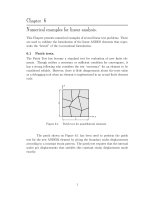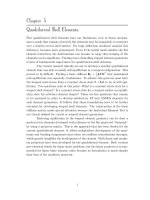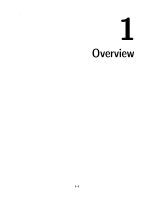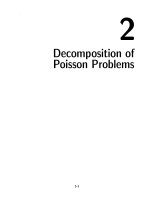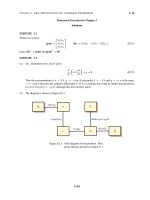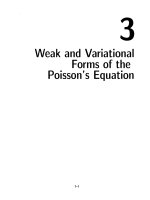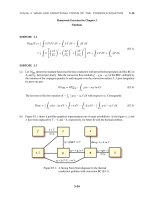advanced dynamic-system simulation
Bạn đang xem bản rút gọn của tài liệu. Xem và tải ngay bản đầy đủ của tài liệu tại đây (3.61 MB, 240 trang )
www.it-ebooks.info
Advanced Dynamic-system
Simulation
Model-replication Techniques and
Monte Carlo Simulation
Granino A. Korn
University of Arizona
Tucson, Arizona
WILEY-INTERSCIENCE
A JOHN WILEY & SONS, INC., PUBLICATION
www.it-ebooks.info
www.it-ebooks.info
Advanced Dynamic-system
Simulation
www.it-ebooks.info
www.it-ebooks.info
Advanced Dynamic-system
Simulation
Model-replication Techniques and
Monte Carlo Simulation
Granino A. Korn
University of Arizona
Tucson, Arizona
WILEY-INTERSCIENCE
A JOHN WILEY & SONS, INC., PUBLICATION
www.it-ebooks.info
Copyright © 2007 by John Wiley & Sons, Inc. All rights reserved.
Published by John Wiley & Sons, Inc., Hoboken, New Jersey
Published simultaneously in Canada
No part of this publication may be reproduced, stored in a retrieval system, or transmitted in any form or
by any means, electronic, mechanical, photocopying, recording, scanning, or otherwise, except as
permitted under Section 107 or 108 of the 1976 United States Copyright Act, without either the prior
written permission of the Publisher, or authorization through payment of the appropriate per-copy fee to
the Copyright Clearance Center, Inc., 222 Rosewood Drive, Danvers, MA 01923, 978-750-8400, fax
978-750-4470, or on the web at www.copyright.com. Requests to the Publisher for permission should be
addressed to the Permissions Department, John Wiley & Sons, Inc., 111 River Street, Hoboken,
NJ 07030, 201-748-6011, fax 201-748-6008, or online at />Limit of Liability/Disclaimer of Warranty: While the publisher and author have used their best efforts in
preparing this book, they make no representations or warranties with respect to the accuracy or
completeness of the contents of this book and specifically disclaim any implied warranties of
merchantability or fitness for a particular purpose. No warranty may be created or extended by sales
representatives or written sales materials. The advice and strategies contained herein may not be suitable
for your situation. You should consult with a professional where appropriate. Neither the publisher nor
author shall be liable for any loss of profit or any other commercial damages, including but not limited to
special, incidental, consequential, or other damages.
For general information on our other products and services or for technical support, please contact our
Customer Care Department within the United States at 877-762-2974, outside the United States at
317-572-3993 or fax 317-572-4002.
Wiley also publishes its books in a variety of electronic formats. Some content that appears in print may not
be available in electronic formats. For more information about Wiley products, visit our web site at
www.wiley.com.
Library of Congress Cataloging-in-Publication Data:
Korn, Granino Arthur, 1922-
Advanced dynamic-system simulation : model-replication techniques and Monte
Carlo simulation / by Granino A. Korn.
p. cm.
Includes index.
ISBN 978-0-470-08188-4 (cloth/cd)
1. System analysis Simulation methods. 2. Monte Carlo method. I. Title.
QA402. K665 2007
003' .85 dc22
200601618
Printed in the United States of America
10987654321
www.it-ebooks.info
v
Contents
Preface xiii
Chapter 1. Introduction to Dynamic-system Simulation 1
DYNAMIC-SYSTEM MODELS AND COMPUTER PROGRAMS 1
1-1. Computer Modeling and Simulation 1
1-2. Differential-equation Models 2
1-3. Interactive Modeling—Experiment Protocol and Simulation Studies 3
1-4. Simulation Software 4
1-5. OPEN DESIRE and DESIRE 4
HOW A SIMULATION RUN WORKS 5
1-6. Sampling the DYNAMIC Segment Variables 5
1-7. Numerical Integration 10
(a) Euler Integration 10
(b) Improved Integration Rules 10
1-8. Sampling Times and Integration Steps 11
1-9. Sorting Defined-variable Assignments 12
EXAMPLES OF SIMPLE APPLICATIONS 12
1-10. Oscillators and Computer Displays 12
(a) A Linear Harmonic Oscillator 12
(b) A Nonlinear Oscillator and Duffing’s Differential Equation 15
1-11. Space Vehicle Orbits—Variable-step Integration 15
1-12. A Population-dynamics Model 18
1-13. Splicing Multiple Simulation Runs: Billiard-ball Simulation 20
www.it-ebooks.info
CONTROL-SYSTEM EXAMPLES 22
1-14. An Electrical Servomechanism with Motor Field
Delay and Saturation 22
1-15. Control-system Frequency Response 24
1-16. Simulation of a Simple Guided Missile 25
(a) A Guided Torpedo 25
(b) The Complete Simulation Program 28
WHAT DO WE DO WITH ALL THIS? 29
1-17. Simulation Studies in the Real World: A Word of Caution 29
REFERENCES 30
Chapter 2. Models with Difference Equations, Limiters, and Switches 32
SAMPLED-DATA ASSIGNMENTS AND DIFFERENCE EQUATIONS 32
2-1. Sampled-data Difference Equation Systems 32
2-2. “Incremental” Form of Simple Difference Equations 34
2-3. Combining Differential Equations and Sampled-data Operations 35
2-4. A Simple Example 36
2-5. Initializing and Resetting Sampled-data Variables 38
EXAMPLES OF MIXED CONTINUOUS/SAMPLED-DATA SYSTEMS 38
2-6. The Guided Torpedo with Digital Control 38
2-7. Simulation of a Plant with a Digital PID Controller 40
MODELING LIMITERS AND SWITCHES 42
2-8. Limiters, Switches, and Comparators 42
(a) Limiter Functions 42
(b) Switching Functions and Comparators 42
2-9. Numerical Integration of Switch and Limiter Outputs,
Event Prediction, and Display Problems 45
2-10. Using Sampled-data Assignments 46
2-11. Using the step Operator and Heuristic Integration-step Control 46
2-12. Example: Simulation of a Bang-bang Servomechanism 47
LIMITERS, SWITCHES, AND DIFFERENCE EQUATIONS 49
2-13. Limiters, Absolute Value, and Maximum/Minimum Selection 49
2-14. Output-limited Integration 50
2-15. Modeling Signal Quantization 50
2-16. Continuous-variable Difference Equations with Switching and
Limiter Operations 51
(a) Introduction 51
(b) Track-hold Simulation 52
(c) Maximum- and Minimum-value Holding 53
vi
Contents
www.it-ebooks.info
(d) Simple Backlash and Hysteresis Models 53
(e) The Comparator with Hysteresis (Schmitt Trigger) 54
2-17. Signal Generators and Signal Modulation 56
REFERENCES 58
Chapter 3. Programs with Vector/Matrix Operations and Submodels 59
VECTOR ASSIGNMENTS AND VECTOR DIFFERENTIAL EQUATIONS 59
3-1. Arrays, Subscripted Variables, and State-variable Declarations 59
3-2. Vector Operations in DYNAMIC Program Segments—
The Vectorizing Compiler 60
(a) Vector Assignments and Vector Expressions 60
(b) Vector Differential Equations 61
(c) Vectorization and Model Replication—Significant Applications 62
3-3. Matrix-vector Products in Vector Expressions 63
(a) Definition 63
(b) A Simple Example: Resonating Oscillators 64
3-4. Vector Sampled-data Assignments and Vector Difference Equations 64
3-5. Sorting Vector and Subscripted-variable Assignments 66
MORE VECTOR OPERATIONS 66
3-6. Index-shifted Vectors 66
3-7. Sums,
DOT Products, and Vector Norms 67
(a) Sums and DOT Products 67
(b) Euclidean, Taxicab, and Hamming Norms 67
3-8. Maximum/Minimum Selection and Masking 68
(a) Maximum/Minimum Selection 68
(b) Masking Vector Expressions 69
MATRIX OPERATIONS 69
3-9. Matrix Operations in Experiment-protocol Scripts 69
3-10. Matrix Assignments and Difference Equations in
DYNAMIC Program Segments 70
3-11. Vector and Matrix Operations using Equivalent Vectors 71
VECTORS IN PHYSICS AND CONTROL-SYSTEM PROBLEMS 71
3-12. Vectors in Physics Problems 71
3-13. Simulation of a Nuclear Reactor 72
3-14. Linear Transformations and Rotation Matrices 72
3-15. State-equation Models for Linear Control Systems 74
USER-DEFINED FUNCTIONS AND SUBMODELS 75
3-16. User-defined Functions 75
Contents vii
www.it-ebooks.info
3-17. Submodels 76
(a) Submodel Declaration and Invocation 76
(b) Submodels with Differential Equations 78
3-18. Dealing with Sampled-data Assignments, Limiters, and Switches 78
REFERENCES 79
Chapter 4. Parameter-influence Studies, Model Replication, and
Monte Carlo Simulation 80
PARAMETER-INFLUENCE STUDIES AND VECTORIZATION 80
4-1. Exploring the Effects of Parameter Changes 80
4-2. Repeated Runs and Model-Replication (Vectorization) 81
(a) A Simple Repeated-run Study 81
(b) Model Replication 82
(c) Dealing with Multiple Parameters 84
4-3. Programming Parameter-influence Studies 85
(a) Introduction 85
(b) Measures of System Effectiveness 85
(c) Crossplotting Results 86
(d) Maximum/Minimum Selection 87
(e) Iterative Parameter Optimization 87
RANDOM PROCESSES AND RANDOM PARAMETERS 88
4-4. Random Processes and Monte Carlo Simulation 88
4-5. Generating Random Parameters and Random Initial Values 89
MONTE CARLO SIMULATION OF DYNAMIC SYSTEMS 89
4-6. Repeated-run Monte Carlo Simulation 89
(a) Taking Statistics on Repeated Simulation Runs 89
(b) Sequential Monte Carlo Studies 91
(c) Example: Effects of Gun-elevation Errors on the 1776 Cannon 91
4-7. Vectorized (Model-replicating) Monte Carlo Simulation 93
(a) Vectorized Monte Carlo Study of the 1776 Cannon Shot 93
(b) Interactive Monte Carlo Simulation: Computing Time Histories of
Statistics with Compiled DOT Operations 96
4-8. Statistical Relative Frequencies, Sample Ranges, and Other Statistics 96
4-9. Post-run Probability-density Estimation 97
(a) A Simple Probability-density Estimate 97
(b) Triangle and Parzen Windows 98
(c) Computation and Display of Parzen Window Estimates 99
4-10. Combining Vectorized and Repeated-run
Monte Carlo Simulation 100
REFERENCES 103
viii
Contents
www.it-ebooks.info
Chapter 5. Random-process Simulation and Monte Carlo Studies
with Noisy Signals 105
COMPUTER MODELS OF NOISE PROCESSES 105
5-1. Noise in DYNAMIC Program Segments 105
5-2. Sampled-data Random Processes 105
(a) A Platform for Sampled-data Experiments 105
(b) A Sampled-data Random Process Model: Coin Tossing 106
(c) Recursive Sampled-data Addition and Time Averaging 106
5-3. Modeling Continuous Noise 107
(a) Deriving “Continuous” Noise from Periodic
Pseudorandom Samples 107
(b) “Continuous” Time Averages 109
5-4. Problems with Simulated Noise 109
MONTE CARLO SIMULATION WITH NOISY SIGNALS 109
5-5. Gambling Returns 109
5-6. A Continuous Random Walk 112
5-7. The 1776 Cannonball with Air Turbulence 113
SIMULATION OF NOISY CONTROL SYSTEMS 116
5-8. Monte Carlo Simulation of a Nonlinear Servomechanism:
A Noise-input Test 116
5-9. Monte Carlo Study of Control-system Errors Caused by Noise 119
ADDITIONAL TOPICS 119
5-10. Monte Carlo Optimization 119
5-11. A Convenient Heuristic Method for Testing Pseudorandom Noise 121
5-12. An Alternative to Monte Carlo Simulation 121
(a) Introduction 121
(b) Dynamic Systems with Random Perturbations 122
(c) Mean Square Errors in Linearized Systems 122
REFERENCES 123
Chapter 6. Vector Models of Neural Networks 125
NEURAL-NETWORK SIMULATION 125
6-1. Neural-network Models and Pattern Vectors 125
6-2. Simple Vector Operations Model Neural-network Layers 126
6-3. Normalizing and Contrast-enhancing Neuron Layers 127
6-4. Multilayer Networks 128
6-5. Exercising a Neural-network Model 129
(a) Computing Successive Neuron Layer Outputs 129
(b) Using Pattern-row Matrices 129
(c) Pattern Input from Files 130
Contents ix
www.it-ebooks.info
REGRESSION AND PATTERN CLASSIFICATION 130
6-6. Mean-square Regression 131
6-7. Pattern Classification 131
NEURAL-NETWORK TRAINING: PATTERN CLASSIFICATION
AND ASSOCIATIVE MEMORY 132
6-8. Linear Pattern Classifiers 132
6-9. The LMS Algorithm 132
6-10. A Softmax Image Classifier 133
(a) Problem Statement and Experiment-protocol Script 133
(b) Network Model and Training 134
(c) Test Runs and A Posteriori Probabilities 137
6-11. Associative Memory 138
NONLINEAR MULTILAYER NETWORKS 138
6-12. Backpropagation Networks 138
(a) The Backpropagation Algorithm 138
(b) Discussion 140
(c) Examples and Neural-network Submodels 141
6-13. Radial-basis-function Networks 141
(a) Basis-function Expansion and Linear Optimization 141
(b) Radial Basis Functions 144
COMPETITIVE-LAYER PATTERN CLASSIFICATION 146
6-14. Template-pattern Matching 146
6-15. Unsupervised Pattern Classifiers 147
(a) Simple Competitive Learning 147
(b) Learning with Conscience 148
6-16. Experiments with Pattern Classification
and Vector Quantization 149
(a) Pattern Classification 149
(b) Vector Quantization 150
6-17. Simplified Adaptive-resonance Emulation 151
6-18. Biologically Plausible Competition: Correlation Matching 153
SUPERVISED COMPETITIVE LEARNING 154
6-19. Supervised Competitive Classifiers: The LVQ Algorithm 154
6-20. Counterpropagation Networks 155
NEURAL NETWORKS WITH MEMORY 155
6-21. Neural Networks and Memory 155
6-22. Networks with a Delay-line Input Layer 157
(a) Vector Model of a Tapped Delay Line 157
(b) Simple Linear Filters 158
x
Contents
www.it-ebooks.info
(c) Linear Matched Filters, Signal Classifiers,
and Model Matching 159
(d) A Nonlinear Predictor Trained with Backpropagation 159
6-23. The Gamma Delay Line Layer 162
PULSED-NEURON REPLICATION 163
6-24. Pulsed-neuron Models 163
6-25. A Simple Integrate and Fire Model 164
6-26. Neuron-model Replication 166
REFERENCES 168
Chapter 7. More Applications of Vector Models 171
A VECTORIZED SIMULATION WITH LOGARITHMIC PLOTS 171
7-1. The EUROSIM No. 1 Benchmark Problem 171
7-2. Vectorized Simulation with Logarithmic Plots 171
MODELING FUZZY-LOGIC FUNCTION GENERATORS 172
7-3. Rule Tables Specify Heuristic Functions 172
7-4. Fuzzy-set Logic 174
(a) Fuzzy Sets and Membership Functions 174
(b) Fuzzy Intersections and Unions 175
(c) Joint Membership Functions 175
(d) Normalized Fuzzy-set Partitions 175
7-5. Fuzzy-set Rule Tables and Function Generators 178
7-6. Simplified Function Generation with Fuzzy Basis Functions 179
7-7. Vector Models of Fuzzy-set Partitions 179
(a) Gaussian Bumps—Effects of Normalization 179
(b) Triangle Functions 180
(c) Smooth Fuzzy Basis Functions 181
7-8. Vector Models for Multidimensional Fuzzy-set Partitions 181
7-9. Example: Fuzzy-logic Control of a Servomechanism 182
(a) Problem Statement 182
(b) Experiment Protocol and Rule Table 183
(c) DYNAMIC Program Segment and Results 184
PARTIAL DIFFERENTIAL EQUATIONS 186
7-10. The Method of Lines 186
7-11. The Vectorized Method of Lines 188
(a) Introduction 188
(b) Using Differentiation Operators 188
(c) Numerical Problems 191
7-12. The Heat-conduction Equation in Cylindrical Coordinates 192
Contents xi
www.it-ebooks.info
7-13. Generalizations 192
7-14. A Simple Heat-exchanger Model 194
REPLICATION OF AGROECOLOGICAL MODELS ON MAP GRIDS 197
7-15. A Geographical Information System 197
7-16. Modeling the Evolution of Landscape Features 197
REFERENCES 199
Appendix 201
ADDITIONAL REFERENCE MATERIAL 201
A-1. Example of a Radial-basis-function Network 201
A-2. A Fuzzy-basis-function Network 203
A-3. The CLEARN Algorithm 205
REFERENCES 206
PROGRAMS IN THE BOOK CD 210
STREAMLINED OPERATION OF DESIRE PROJECTS UNDER LINUX 210
Index 213
xii
Contents
www.it-ebooks.info
xiii
Preface
Simulation is experimentation with models. This book describes new com-
puter programs for interactive modeling and simulation of dynamic systems,
such as aerospace vehicles, control systems, and biological systems.
Simulation studies for design or research can involve many hundreds of
model changes, so programming must be convenient, and computations must
be as fast as possible.
This book is about advanced simulation programming and describes many
new techniques. We provide only a brief review of routine simulation pro-
gramming but demonstrate computer software for remarkably fast and
respectably large simulation studies on inexpensive personal computers or
workstations. For hands-on experiments, the enclosed CD contains an indus-
trial-strength software package rather than a toy demonstration program.
1
1
OPEN DESIRE solves up to 40,000 ordinary differential equations under Linux, and up to
20,0000 differential equations under Microsoft Windows
TM
, so that one can implement
respectable vectorized Monte Carlo studies. The DESIRE language, widely used since 1985,
accepts scalar and vector differential equations and difference equations in a natural mathe-
matical notation, for example,
d/dt x = – x * cos(w * t) + 2.22 * a * x
Vector y = A * x + B * u
Programs entered in editor windows immediately compile, execute, and produce solution dis-
plays. The program in the book CD allows the user to experiment with all the examples in the
text. The Open Source programs in the book CD include binary and source code and a com-
prehensive reference manual. The Linux version can be recompiled for other Unix-type
systems, including Solaris© and Cygwin (Unix under Windows©).
www.it-ebooks.info
xiv Preface
The included OPEN DESIRE program for Linux solves up to 40,000 ordi-
nary differential equations and implements exceptionally fast and convenient
vector operations. A smaller educational 20,000 differential-equations ver-
sion for Microsoft Windows
TM
can be obtained without charge from the
author by sending an email to The user can run, edit,
and modify the example simulations keyed to the figures in this book, plus
many other examples. Many of our programming principles also apply to
simulation programs other than DESIRE.
Chapter 1 introduces our subject with a few programs for small differen-
tial-equation models, including a simple guided-missile simulation. The
remainder of the book presents new material. Chapter 2 begins with a careful
discussion of models that involve sampled-data operations and sampled-data
difference equations together with differential equations. We model mixed
analog–digital systems such as simulated digital controllers and systems with
limiters and switches. At this point, we show that many very useful devices
(e.g., track-hold circuits, trigger circuits, signal generators, automatic scal-
ing) are neatly and efficiently modeled with simple difference equations.
Last, but not least, we propose improved techniques for proper numerical
integration of switched variables.
Truly powerful simulation programs need a readable notation for vector
and matrix assignments, differential equations, and difference equations.
Chapter 3 introduces a novel vector compiler that produces very fast pro-
grams for vector and matrix operations. We also demonstrate efficient use of
submodels. We present examples from control engineering and nuclear-reac-
tor simulation. The following chapter then shows how we use vectors to repli-
cate complete models.
Chapter 4 describes practical model replication (vectorization): a single sim-
ulation run with a vector model will replace hundreds or thousands of conven-
tional simulation runs. We apply the vectorizing compiler introduced in Chapter
3 to parameter-influence studies and Monte Carlo simulation of dynamic sys-
tems with noise-perturbed parameters and random initial conditions. We com-
pare repeated-run and vectorized Monte Carlo studies of a weapon trajectory.
Our interactive programs produce not just time histories of system variables but
also time histories of statistics such as averages, mean squares, and probability
estimates. We also show explicitly how to estimate probability densities.
Chapter 5 discusses more difficult vectorized Monte Carlo simulations
involving time-varying noise, which has to be derived from periodic pseudo-
random noise samples. Examples include Monte Carlo simulation of a contin-
uous random walk, another trajectory study, and two vectorized control-system
simulations. An inexpensive 2.4-GHz personal computer exercised 1000
random-input control-system models in seconds. We also describe a new heuris-
tic test for the quality of pseudorandom noise.
www.it-ebooks.info
Chapter 6 discusses vector models of neural networks including a new
pulsed-neuron model. Chapter 7 deals with vectorized programs for fuzzy-set
controllers, partial differential equations, and agroecological models repli-
cated at many points of a landscape map. The Appendix gets a small selection
of reference material out of the way of the main text.
G
RANINO A. KORN
Chelan, Washington
October 2006
Preface xv
www.it-ebooks.info
www.it-ebooks.info
1
Introduction to
Dynamic-system Simulation
DYNAMIC-SYSTEM MODELS AND COMPUTER PROGRAMS
1-1. Computer Modeling and Simulation
Simulation is experimentation with models. Simulation for engineering
design, research, and education studies must rapidly exercise a wide variety
of models and then store and access a large volume of results. This is practi-
cal only with models programmed on computers.
Dynamic-system models relate model-system states to earlier states. Classical
physics, for example, predicts continuous changes of quantities such as position,
velocity, or voltage with continuous time. Computer simulation of such systems
started in the aerospace industry and is now indispensable in biology, medicine,
and agroecology as well as in all engineering disciplines. At the same time, dis-
crete-event simulation has gained importance for business and military planning.
Simulation is at its best when combined with mathematical analyses. But
simulation results can often provide insight and possibly useful decisions
where exact analysis is impractical. This was true for many early control-
system optimizations. As another example, Monte Carlo simulations simple-
mindedly measure statistics over repeated experiments to solve problems that
are too complicated for probability theory analysis. Simulation results must
eventually be validated by real experiments, just like analytical results.
1
Advanced Dynamic-system Simulation: Model-replication Techniques
and Monte Carlo Simulation By Granino A. Korn
Copyright © 2007 by John Wiley & Sons, Inc.
www.it-ebooks.info
2 Introduction to Dynamic-system Simulation
Computer simulations can be speeded up or slowed down at the experi-
menter’s convenience. You can simulate a flight to Mars or to Alpha Centauri
in one second. Periodic clock interrupts synchronizing suitably scaled simu-
lations with real time permit “hardware in the loop”: you can “fly” a real
autopilot—or a real human pilot—on a tilting platform controlled by a com-
puter flight simulation. In this book, we are interested in very fast simulation,
for we want to study the effects of many different model changes.
Specifically, we want to
1. Enter and edit programs in convenient editor windows.
2. Use typed or graphical-interface commands to start, stop, and pause
simulations, to select displays, and to make parameter changes. Results
ought to appear immediately to provide an intuitive “feel” for the
effects of model changes (interactive modeling).
3. Program systematic parameter-influence studies and produce cross-
plots or tables.
4. Program model changes to optimize effectiveness measures, and study
effects of random parameter changes or random model inputs by taking
statistics on repeated simulations (Monte Carlo simulation).
1-2. Differential-equation Models
Continuous-system simulation models delayed interactions of physical state
variables
x1, x2, … with first-order ordinary differential equations (state
equations)
(d/dt) xi = fi(t; x1, x2, …; y1, y2, …; a1, a2, …) (i = 1, 2, …) (1-1a)
Here
t represents the time, and the quantities
yj = gj(t; x1, x2, ; y1, y2, …; b1, b2, …) (j = 1, 2, …) (1-1b)
are defined variables.
a1, a2, …, and b1, b2, … are constant model
parameters.
Simulation programs exercise such models by solving the state-equation
system (1-1) to produce time histories of the system variables
xi = xi(t) and
yj = yj(t) for t = t0 to t = t0 + TMAX, starting with given initial values t0 and
xi(t0). In Section 1-6 and Chapter 2, we shall add sampled-data operations
representing periodic inputs and outputs, sample-holds, and digital
controllers.
www.it-ebooks.info
The state variables xi are system outputs. They start at t = t0 with given
initial values; subsequent values are produced by an integration routine
(Section 1-7) from the
fi-values generated by the preceding execution
(derivative call) of the operations (1).
There are three kinds of defined variables
yj:
1. system inputs (specified functions of the time
t)
2. system outputs
3. intermediate results needed to compute the derivatives
fi
It must be possible to sort the defined-variable assignments (1-1b) into a pro-
cedure that successively derives all the
yj from state variables xi and/or the
time
t without recurrence relations or “algebraic loops” (Section 1-9).
Some dynamic systems (e.g., systems involving interconnected mechani-
cal devices in automotive engineering and robotics) are modeled with differ-
ential-equation systems that cannot be explicitly solved for state-variable
derivatives as in Eq. (1-1). Simulation then requires solution of algebraic
equations at each integration step. Such differential-algebraic-equation
(DAE) systems are not treated in this book. References [1–4] describe suit-
able mathematical methods and special software.
1-3. Interactive Modeling—Experiment Protocol and
Simulation Studies
Practical computer simulation is not simply a matter of programming and
solving model equations. We must also make it convenient to modify our
models and try many different experiments (see also Section 1-5). In addition
to DYNAMIC program segments listing the model equations (1-1), each sim-
ulation study requires an experiment protocol program that sets and changes
initial conditions and model parameters, calls computer runs, and displays or
tabulates solutions for different model configurations.
The simplest experiment protocols are just sequences of successive
commands, say
a = 20.0 | b = – 3.35 (set parameter values)
x = 12.0 (set the initial value of x)
drun (make a differential-equation
-solving simulation run)
reset (reset initial values)
a = 20.1 (change model parameters)
b = b – 2.2
drun (try another run)
Dynamic-system Models and Computer Programs 3
www.it-ebooks.info
Each drun command calls a differential-equation-solving simulation run, and
reset resets initial conditions. Typed commands ought to execute immediately
to permit interactive modeling. The operator inspects the solution output after
each simulation run and then types new commands for the next run. Command-
mode operation also permits interactive program debugging [5].
A simulation study combines such commands into a storable program seg-
ment (experiment-protocol script) that can branch and loop to call repeated
simulation runs for different parameter combinations. Simulation studies
may involve thousands of model and parameter changes, so programming
must be easy and computations must be as fast as possible. This is why we
like to interpret experiment-protocol scripts and compile the program seg-
ments executing the actual simulation runs.
1-4. Simulation Software
Commercially available equation-oriented simulation programs such as
ACSL
TM
accept system equations in a more or less human-readable form,
sort defined variable assignments as needed, and feed the sorted equations to
an optimizing Fortran or c compiler [5]. Berkeley Madonna and DESIRE
(see below) have built-in equation-language compilers and execute immedi-
ately. Block-diagram interpreters (e.g., Simulink
TM
, Vissim
TM
, and the open-
source program Scicos) permit graphical block-diagram composition and
immediately execute interpreted simulation runs. Such programs usually pro-
vide equation-language blocks for complicated expressions. Interpreted code
is slow; production runs are sometimes translated into c for faster execution.
Alternatively, ACSL
TM
, Easy5
TM
, and Berkeley Madonna have block-diagram
preprocessors for compiled simulation programs. More advanced modeling
is possible with the Modelica language [6–8].
1-5. OPEN DESIRE and DESIRE
The simulation programs described in this book, and, in particular, our new
techniques for model replication (vectorization), Monte Carlo simulation,
and submodels (Chapters 3–7), use the open-software simulation package
OPEN DESIRE for Linux, Unix including Cygwin (Unix under Windows),
and Microsoft Windows
TM
, or the commercially available DESIRE/2000
program for Windows.
1
DESIRE simulation systems allow inexpensive per-
sonal computers and workstations solve thousands of differential equations
in seconds.
4 Introduction to Dynamic-system Simulation
1
The earlier (1995) Windows version of DESIRE discussed in References [1,2] lacks the
vector-compilation features used in this book.
www.it-ebooks.info
How a Simulation Run Works 5
DESIRE uses double-precision (64-bit) floating-point arithmetic and
accepts command scripts and model descriptions in a readable mathematical
notation such as
y = a
*
cos(x) + b d/dt x = – x + 4
*
y
Command scripts can include operating-system calls, shell scripts, and calls to
other computer programs. DESIRE’s command-script language is itself a
general-purpose mathematical language and handles vectors, matrices, and
even complex numbers (e.g., for frequency-response and root-locus plots) [9].
Programs are entered and edited in editor windows (Fig. 1-1). Each program
begins with an experiment-protocol script that is interpreted much like an
advanced Basic dialect. When the experiment-protocol script encounters a
drun statement, a built-in runtime compiler automatically compiles a
DYNAMIC program segment listing model equations. The state-equation-
solving simulation run then executes at once and produces solution displays
in bright color.
Very fast compilation (typically under 50 ms) simplifies interactive mod-
eling. Experimenters can immediately observe results of programmed or
screen-edited models and experiment-protocol changes. One can enter and
edit different models in multiple editor windows and run these models in turn
to compare results (Fig. 1-1). Runtime displays show solution time histories
and error messages during rather than after each simulation run, so that you
can save time by aborting undesirable runs before they complete.
The experiment-protocol script starting each DESIRE program defines an
experiment. Subsequent DYNAMIC program segments define models used
in the experiment and specify runtime input/output requests. An experiment
protocol can call multiple DYNAMIC segments with different models, dif-
ferent versions of the same model, and/or different input/output operations.
HOW A SIMULATION RUN WORKS
1-6. Sampling the DYNAMIC Segment Variables
When
drun calls a simulation run, the program initializes input/output opera-
tions requested by the DYNAMIC program segment. The independent variable
t (simulation time) and the differential-equation state variables start with initial
values assigned by the experiment protocol.
2
A first pass through the
DYNAMIC-segment code [Eq. (1-1)] produces initial values of the defined
2
Unspecified initial values of unsubscripted differential-equation state variables conveniently
default to 0.
www.it-ebooks.info
6 Introduction to Dynamic-system Simulation
FIGURE 1-1
a
. OPEN DESIRE running under Linux. The first dual-monitor screen shows a
file-manager window for calling user programs, the DESIRE command window, a graph win-
dow, and an editor window. The second screen has a file manager and three editor windows;
one can click on any file-manager or editor window to run and compare different programs.
On the third screen, two independent simulations run in separate command windows. Solution
graphs were set to black-on-white for publication, but normally each displayed curve has a dif-
ferent color.
www.it-ebooks.info

